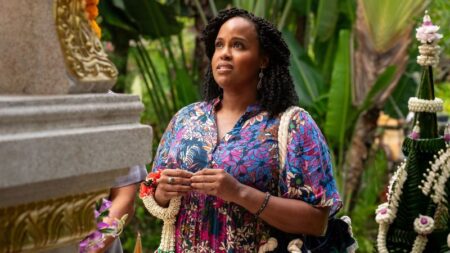As we reach the end of the three-season journey of “And Just Like That,” the sequel to the iconic series “Sex and the City,” it prompts an inevitable reflection: how did we arrive here, and why was the road such a blend of emotional highs and lows? This continuation of Carrie Bradshaw’s saga, portrayed by Sarah Jessica Parker, along with her beloved friends, is profoundly layered, steeped in nostalgia, joy, and, at times, disappointment.
Originally, “Sex and the City” set the tone for a quintessential exploration of friendship, love, and sexuality. However, “And Just Like That,” despite its familiar characters, faced an uphill battle. It documented the women’s lives against the vibrant backdrop of contemporary New York City, yet struggled to resonate with fans who held the original series to such high regard. The series concluded its run on HBO Max – owned by CNN’s parent company, Warner Bros. Discovery – sparking expected polarized reactions, given its complex blend of triumphs and trials.
The show garnered its share of criticism, particularly for relying on shock value and tragedy. The death of Mr. Big (Chris Noth), arguably the love of Carrie’s life, at the very beginning of the series was a contentious choice. Many fans felt this abrupt twist overshadowed the series premiere with somberness. This moment was compounded by the off-screen death of Willie Garson, a beloved cast member, and the absence of Samantha Jones (played by Kim Cattrall), recognized as a vital part of the original group. Viewers were left grappling with these losses rather than enjoying the story’s continuity.
Amidst this sorrow, however, seasons the show also brought forth significant moments of growth and realization. For instance, Carrie and Aidan (John Corbett) found themselves breaking up for a third time, embodying the harsh reality that love does not always overcome deep-seated trust issues. Their narrative brought to light the fact that some relationships cycle through repeated conflicts despite profound feelings. It underscoreed the lesson that even ostensibly perfect scenarios could crumble under the weight of past mistakes and unresolved tensions.
An early struggle for “And Just Like That” was its crowded narrative, which diverted focus from the essential relationships that defined the original series. With a plethora of new characters, including Che Diaz (Sara Ramirez) and Nya Wallace (Karen Pittman), the show sometimes felt overwhelmed, attempting to juggle multiple storylines without honing in on the core friendships that fans cherished. Gradually, this clutter begun to lessen, allowing some of the newer dynamics—especially between Charlotte York (Kristin Davis) and Lisa Todd Wexley (Ari Nicole Parker)—to shine through as meaningful and profound.
Season three took strides in emphasizing these evolving friendships, particularly through the bond formed between Charlotte and LTW, showcasing a connection that feels genuine and layered. Various poignant moments highlighted their support for one another, especially international crises like Harry’s health, adding emotional depth that resonated with fans.
On the converse side, significant missteps left fans feeling disconnected. Stanford Blatch (Willie Garson) was abruptly written off the show in a bewildering manner, drastically undermining his history with the series. As Carrie lost one of her most integral allies, the show seemed to downplay the emotional significance of his departure.
Additionally, Miranda Hobbes (Cynthia Nixon) crafted an intriguing evolution throughout the series; however, this evolution came at the expense of Steve Brady (David Eigenberg), who was reduced to merely supporting cameos. His limited presence in Miranda’s life felt dissatisfying, especially given the chemistry they once shared. As Carrie’s tumultuous tales and Charlotte’s fulfilling journeys took center stage, Steve’s sidelining became a noticeable flaw in the narrative.
As the series finale draws near, the anticipation builds for how these stories will culminate. The balance of highs and lows ultimately reflects the everyday realities of life. Fans are left wondering what the future holds for Carrie, Miranda, and Charlotte as they navigate not only their love lives but the evolving nature of their friendships in a vastly changing world. The finale airs on HBO Max, presenting an opportunity to tie together the threads of joy, sorrow, growth, and perhaps find a bittersweet closure to this pioneering tale of New York women’s lives.












